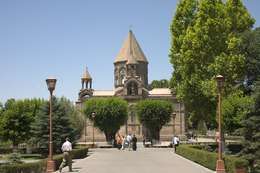Vagharshapat
Vagharshapat (Armenian: Վաղարշապատ pronounced [vɑʁɑɾʃɑˈpɑt]), is the 4th-largest city in Armenia and the most populous municipal community of Armavir Province, located about 18 km (11 mi) west of the capital Yerevan, and 10 km (6 mi) north of the closed Turkish-Armenian border. It is commonly known as Ejmiatsin (also spelled Echmiadzin or Etchmiadzin, Էջմիածին, pronounced [ɛd͡ʒmjɑˈt͡sin]), which was its official name between 1945 and 1995.[3] It is still commonly used colloquially and in official bureaucracy.[4]
Vagharshapat Վաղարշապատ | |
|---|---|
City | |
 | |
 Flag .jpg) Seal | |
 Vagharshapat | |
| Coordinates: 40°10′22″N 44°17′33″E | |
| Country | |
| Marz (Province) | Armavir |
| Founded | 685 BC |
| Government | |
| • Mayor | Diana Gasparyan |
| Area | |
| • Total | 40 km2 (20 sq mi) |
| Elevation | 853 m (2,799 ft) |
| Population (2011 census) | |
| • Total | 46,540 |
| • Estimate (1 January 2019) | 46,200[1] |
| • Density | 1,200/km2 (3,000/sq mi) |
| Time zone | UTC+4 ( ) |
| Area code(s) | 0231 |
| Website | www.ejmiatsin.am |
| Sources: Population[2] | |
| Official name | Cathedral and Churches of Echmiatsin and the Archaeological Site of Zvartnots |
| Includes |
|
| Criteria | Cultural: (ii)(iii) |
| Reference | 1011 |
| Inscription | 2000 (24th session) |
| Area | 74.3 ha (184 acres) |
The city is best known as the location of Etchmiadzin Cathedral and Mother See of Holy Etchmiadzin, the center of the Armenian Apostolic Church. It is thus unofficially known in Western sources as a "holy city"[5][6] and in Armenia as the country's "spiritual capital" (հոգևոր մայրաքաղաք).[7] It was one of the major cities and a capital of ancient Greater Armenia.[8] Reduced to a small town by the early 20th century, it experienced large expansion during the Soviet period becoming, effectively, a suburb of Yerevan.[9][10] Its population stands just over 37,000 based on 2016 estimates.
Etymology
According to Movses Khorenatsi, the area of Vagharshapat was known as Artimed (Արտիմէդ), derived from the ancient Greek deity Artemis. Later, it was renamed Avan Vardgesi (Աւան Վարդգէսի, "Town of Vardges") or Vardgesavan (Վարդգէսաւան) by Prince Vardges Manouk who rebuilt the settlement near the shores of Kasagh River, during the reign of King Orontes I Sakavakyats of Armenia (570–560 BC). However, in his first book, Wars of Justinian, the Byzantine historian Procopius refers to the city as Valashabad (Balashabad), named after King Valash (Balash) of Armenia. The name evolved into its later form by the shift of the medial l into a gh, which is common in the Armenian language. Movses Khorenatsi mentioned that the town of Vardges was entirely rebuilt and fenced by King Vagharsh I to become known as Norakaghak (Նորաքաղաք, "New City") and later Vagharshapat.
History
Early history
The territory of ancient Vagharshapat was inhabited since the 3rd millennium BC. Many sites, such as Metsamor Castle, Shresh hill and Mokhrablur hill date back to the neolithic period. The first written records about Vagharshapat were found in the inscriptions left by the Urartian king Rusa II (685–645 BC), where it was mentioned as Kuarlini (Կուարլինի). The inscription found in the archaeological site of ancient Vagharshapat cites to a water canal opened by king Rusa II, between Ildaruni river (Hrazdan River) and the valley of Kuarlini.
According to 5th-century writer Movses Khorenatsi, the oldest name of Vagharshapat was Artimed (Արտիմէդ), derived from the ancient Greek deity Artemis. Later, it was renamed Avan Vardgesi (Աւան Վարդգէսի, "Town of Vardges") or Vardgesavan (Վարդգէսաւան) after being rebuilt by prince Vardges Manouk near the shores of Kasagh River, during the reign of king Orontes I Sakavakyats of Armenia (570–560 BC).
Under the reign of king Tigranes the Great (95–55 BC), the town was partly inhabited by Jewish captives.
In the first half of the 1st century AD, under the reign of the Armenian Arsacid king Vagharsh I of Armenia (117–144), the old town of Vardgesavan was renovated and renamed Vagharshapat (Վաղարշապատ). In his first book Wars of Justinian, the Byzantine historian Procopius has cited to the city as Valashabad (Balashabad), named after king Valash (Balash) of Armenia. The name evolved into its later form by the shift in the medial L into a Gh, which is common in the Armenian language. Movses Khorenatsi mentioned that the Town of Vardges was entirely rebuilt and fenced by king Vagharsh I to become known as Noarakaghak (Նորաքաղաք, "New City") and later Vagharshapat.
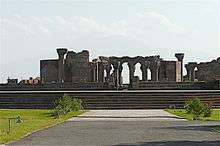
Vagharshapat has served as the capital of the Arsacid Kingdom of Armenia between 120 AD and 330 AD. After embracing Christianity as a state religion in Armenia in 301, Vagharshapat was gradually called Ejmiatsin (Armenian: Էջմիածին), after the name of the Mother Cathedral; the seat of the Armenian Catholicosate, which is considered as one of the oldest religious organizations in the world. As a spiritual centre of the entire Armenian nation, Vagharshapat has grown up rapidly and developed as an important centre of education and culture. The city was home to one of the oldest educational institutions in Armenia founded by Mesrop Mashtots.
The political capital of the Armenian kingdom was transferred to the city of Dvin in 336.
Middle Ages
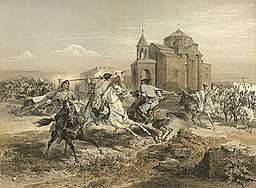
Vagharshapat maintained its status as the country's most important city until the fall of the Arsacid Kingdom in 428. The city has gradually lost its importance under the Persian rule, specifically when the seat of the Catholicosate was transferred to Dvin in 452. However, the first manuscript library in Armenia was founded in 480 in Vagharshapat.
The Armenian Church rejected the Council of Chalcedon (451) because they believed the Chalcedonian christology was too similar to Nestorianism; however, some Armenian bishops who were present in the territories of Roman Armenia signed the Council's documents and also accepted Pope Leo I's 458 encyclical mandating adherence to the Chalcedonian Definition. In Persarmenia, the Persian Nestorian Church supported the spread of Nestorianism, which the Armenian Church had previously declared heretical and saw as a threat to the independence of their Church. Peter the Iberian, a Georgian prince, also strongly opposed the Chalcedonian Creed.[11] Thus, in 491, Catholicos Babken I of Armenia, along with the Albanian and Iberian bishops met in Vagharshapat and issued a condemnation of the Chalcedonian Definition.[12]
In 587 during the reign of emperor Maurice, Vagharshapat (then called Valarshapat) and much of Armenia came under Roman administration after the Romans defeated the Sassanid Persian Empire at the battle of the Blarathon.
In 658 AD, Vagharshapat, along with the rest of the Armenian highland, was conquered by the Arabs. The city was briefly revived between the 9th and 11th centuries under the Bagratid Kingdom of Armenia, before being overrun by the Byzantines in 1045 and later by the Seljuks in 1064.
In the middle of the 13th century, Vagharshapat became part of the Ilkhanate of the Mongol Empire. During the last quarter of the 14th century the Aq Qoyunlu Sunni Oghuz Turkic tribe took over Armenia, including Vagharshapat.
In 1400, when Timur invaded Armenia and Georgia many districts including Vagharshapat were depopulated under the rule of the Timurid Empire.[13] In 1410, Armenia fell under the control of the Kara Koyunlu Shia Oghuz Turkic tribe. Under the Turkic-Mongol rule, Vagharshapat was known to the Turks as Uchkilisa (Üçkilise, "three churches" in Turkic).

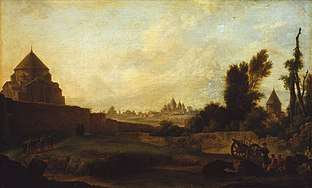
The influence of Vagharshapat waned between 1045 and 1441, when the seat of the Armenian Catholicosate was transferred from the Cilician city of Sis back to Etchmiadzin.
Early modern period
Between 1502 and 1828, Armenia became part of the Persian state under the rule of Safaavid, Afsharid and Qajar dynasties, with short periods of Ottoman rule between 1578 and 1603 and later between 1722 and 1736.
In 1828, after the Russo-Persian War, Vagharshapat —as a part of the Erivan Khanate— was handed over to the Russian Empire as a result of the Treaty of Turkmenchay signed on 21 February 1828.
In their 1833 book Eli Smith and H. G. O. Dwight described Vagharshapat, then a village, as follows: "It presents nothing but a crowded collection of mud cabins, perhaps 500 in number."[14]
With the establishment of the Erivan Governorate in 1850, Vagharshapat became the centre of the newly formed Echmiadzinsky Uyezd.
Present day
Armenia enjoyed a short period of independence between 1918 and 1920 before falling to the Bolshevik 11th Red Army and becoming part of the Soviet Union. In 1925, the new plan of rebuilding the modern town was introduced by architect Alexander Tamanian. It was finally completed between 1939 and 1943. In 1945, the town of Vagharshapat was officially renamed Etchmiadzin by the Soviet government.
During the 1950s and 1960s, the town has witnessed a massive wave of construction, including residential buildings and industrial plants. By the end of the 1960s, the historical monuments of the town; including the religious complex of the Mother See of Holy Etchmiadzin, Saint Hripsime Church, Saint Gayane Church and the surrounding area of Zvartnots Cathedral, were entirely rehabilitated.[15]
After the independence of Armenia, the town was officially renamed Vagharshapat in 1995. However, the town is still popularly known as Ejmiatsin.
In October 2018, Diana Gasparyan, who was nominated by the Civil Contract Party, was elected mayor of the city and the country's first ever female mayor.[16]

Geography and climate
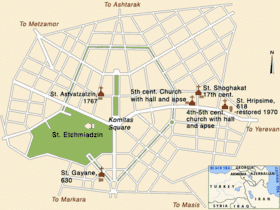
Vagharshapat is the largest satellite-city of Yerevan and the 4th largest in Armenia by population. It is located to the west of Yerevan in the basin of the Kasagh River, in the northeastern extremity of Ararat plain, and very close to Zvartnots International Airport.
According to Moses of Chorene's History of Armenia and as a result of several archaeological researches conducted in the area, the most probable location of the ancient city of Vagharshapat is the area of Shresh Hill near Kasagh River.[17]
Shresh Hill or the Kond of Ghugo, as it was called by the local population, is only 500 metres (1,600 feet) away to the northeast of modern-day Vagharshapat, on the way to Oshakan. It is an artificial hill and has a diameter of 123 metres (404 feet) long. It was first excavated in 1870. In 1913 and 1928, the area was excavated by archaeologist Yervand Lalayan. Large-scale excavations were conducted around the hill and the nearby sites of Metsamor and Mokhrablur between 1945 and 1950.
Historically, Vagharshapat is at the heart of the Armenian Highland, in Aragatsotn canton (Armenian: Արագածոտն գաւառ Aragatsotn gavar, not to be confused with the current Aragatsotn Province) of Ayrarat province, within Armenia Major.
The city has an average elevation of 853 metres (2,799 feet) above sea level. The climate is cold semi-arid (Köppen climate classification BSk).
| Climate data for Vagharshapat | |||||||||||||
|---|---|---|---|---|---|---|---|---|---|---|---|---|---|
| Month | Jan | Feb | Mar | Apr | May | Jun | Jul | Aug | Sep | Oct | Nov | Dec | Year |
| Average high °C (°F) | 1.6 (34.9) |
4.4 (39.9) |
11.6 (52.9) |
19.0 (66.2) |
24.4 (75.9) |
28.8 (83.8) |
33.1 (91.6) |
32.5 (90.5) |
28.4 (83.1) |
20.5 (68.9) |
12.4 (54.3) |
4.9 (40.8) |
18.5 (65.2) |
| Daily mean °C (°F) | −2.9 (26.8) |
−0.5 (31.1) |
5.9 (42.6) |
12.5 (54.5) |
17.4 (63.3) |
21.4 (70.5) |
25.4 (77.7) |
25.0 (77.0) |
20.4 (68.7) |
13.5 (56.3) |
6.8 (44.2) |
0.6 (33.1) |
12.1 (53.8) |
| Average low °C (°F) | −7.3 (18.9) |
−5.3 (22.5) |
0.2 (32.4) |
6.1 (43.0) |
10.5 (50.9) |
14.1 (57.4) |
17.8 (64.0) |
17.5 (63.5) |
12.4 (54.3) |
6.5 (43.7) |
1.2 (34.2) |
−3.6 (25.5) |
5.8 (42.5) |
| Average precipitation mm (inches) | 20 (0.8) |
22 (0.9) |
27 (1.1) |
36 (1.4) |
51 (2.0) |
29 (1.1) |
16 (0.6) |
12 (0.5) |
14 (0.6) |
29 (1.1) |
25 (1.0) |
20 (0.8) |
301 (11.9) |
| Source: Climate-Data.org [18] | |||||||||||||
Demographics
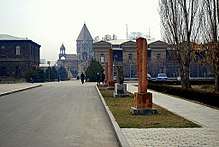
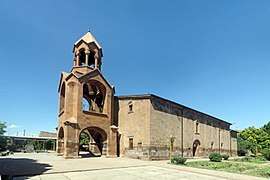
Vagharshapat is the largest urban community of Armavir Province. However, the population of the town has gradually declined since the collapse of the Soviet Union.
The majority of the town's population are ethnic Armenians who belong to the Armenian Apostolic Church. The regulating body of the church is the Diocese of Armavir based in the nearby town of Armavir. Between 1996 and 2014, the Holy Mother of God Church of Vagharshapat has served as the seat of the diocese. Opened in 1767 by Catholicos Simeon I, the church is located at the centre of Vagharshapat, north of the Mother See of Holy Etchmiadzin.[19]
Here is a population timeline of Vagharshapat since 1830:
| Date | Population | Note(s) |
|---|---|---|
| 1830[20] | 2,175 | the fourth largest in the Armenian Oblast |
| c. 1891[21] | 3,000 | overwhelmingly populated by Armenians |
| 1897[22] | 5,267 | 94.8% Armenians |
| 1914[23] | 5,755 | |
| 1926[24] | 8,436 | 99.1% Armenians |
| 1959[23] | 19,560 | |
| 1968[23] | 27,100 | |
| 1976[25] | 42,000 | |
| 1990[23] | 60,000 | |
| 2001[26] | 51,280 | de facto population |
| 2011[26] | 46,540 | de facto population |
Landmarks

1st row: Etchmiadzin Cathedral, Gate of Saint Gregory and the open-air altar
2nd row: Gevorkian Seminary, Vatche and Tamar Manoukian Manuscript Library
3rd row: Clock tower, Church of the Holy Archangels, Gate of King Trdat with the Veharan Pontifical Residence
The religious complex of the Mother See of Holy Etchmiadzin (Armenian: Մայր Աթոռ Սուրբ Էջմիածին) is the spiritual and administrative headquarters of the worldwide Armenian Apostolic Church and the Pontifical Residence of the Supreme Patriarch and Catholicos of All Armenians.

The Mother Cathedral of Holy Etchmiadzin is found in the complex surrounded with many other structures built throughout the centuries. Most buildings are of great architectural significance, such as the old and new Pontifical Residences, the Chancellery or the Divanatoon, the Gate of King Trdat, Alex and Marie Manoogian Treasury Museum (1982), Khrimian Museum, Yeremian Monastic cells, the old Seminary building, the Clock Tower, the Bookstore, etc.
Gevorgian Seminary is a theological college of the Armenian Apostolic Church founded by Catholicos Gevork IV in 1874 within the complex of the Mother See. Apart from the Mother Cathedral, Vagharshapat is home to many other important Armenian churches and cathedrals. The Cathedral of Etchmiadzin, the Churches of Saint Hripsimé, Saint Gayane and Saint Shoghakat, and the archaeological site of Zvartnots are listed among the UNESCO World Heritage Sites.
UNESCO World Heritage Sites
Etchmiadzin Cathedral
Historically, the focal point of the town is the Mother Cathedral of Holy Etchmiadzin, (Armenian: Մայր Տաճար Սուրբ Էջմիածին Mayr Tachar Surp Ejmiatsin) which is one of the oldest churches in the world. It was first built by Saint Gregory the Illuminator as a vaulted basilica in 301–303, when Armenia had just adopted Christianity as a state religion (the first such in world history).[27] The church was enlarged in many occasions, notably in 480, 618 and 1658.
Saints Vartan and Hovhannes Baptistery is a three-domed chapel located north of the Mother Cathedral and designated for baptism ceremonies. It was designed by architects Jim Torosyan and Romeo Julhakyan and consecrated on 26 September 2008, while the construction was funded by the British-Armenian philanthropist Armen Sarkissian.
The Church of the Holy Archangels was built between 2009 and 2011 and located in the yard of Gevorkian Seminary building. The single-domed church was consecrated on 5 November 2011. It was designed by architect Jim Torosyan. The construction work was funded by the Armenian philanthropist Gagik Galstyan.
Saint Hripsime Church
Built in 618, the Church of Saint Hripsimé has basically survived almost unchanged. It is considered one of the oldest surviving churches in Armenia, known for its fine architecture of the classical period, which influenced many other Armenian churches. It was erected in 618 by Catholicos Gomidas atop the original mausoleum, built by Catholicos Sahak the Great in 395, which contained the remains of the martyred Saint Hripsimé. According to the 17th century Armenian historian Arakel of Tabriz, the church was renovated during 1651–1653 by Catholicos Philip I. Repairs were made on the roof, top of the dome, the walls and bases. A cross was placed on top of the roof, and a small portico was added to the western side. It is one of the few churches in Armenian that remained active during the Soviet period.
Saint Gayane Church
Built in 630 by Catholicos Ezra I, Saint Gayane Church is distinguished by its harmonious proportions. It is a three-nave domed basilica with an octagonal drum resting on four internal pillars that divide the interior of the church into three. Its design remained unchanged despite partial renovations of the dome and some ceilings in 1652.
Shoghakat Church
Meaning drop of light, Shoghakat Church is a single-nave domed basilica, built and completed in 1694 by prince Aghamal Sorotetsi during the period of Catholicos Nahabed I. It is built with red and black tufa stones, erected on the remains of a 6th-century basilica. The remains of a 4th-century small chapel could be seen at the southwestern end of Saint Shoghakat Church.[28]
Zvartnots Cathedral
Zvartnots is a 7th-century ruined circular church built upon the order of Catholicos Nerses III the Builder between 641 and 653. It is at the eastern edge of modern-day Vagharshapat. Zvartnots was a majestic cathedral famous for its unique design, dedicated to Saint George, built at the place where a meeting between king Tiridates III and Saint Gregory the Illuminator was supposed to have taken place. In 930, the church was ruined by an earthquake and remained buried until it was rediscovered in the early 20th century by architect Toros Toramanian. The site was excavated between 1900 and 1907, uncovering the foundations of the cathedral as well as the remains of the Pontifical palace and a winery.
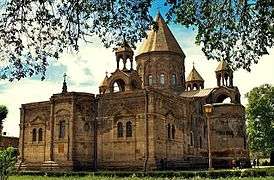 Etchmiadzin Cathedral, opened in 303
Etchmiadzin Cathedral, opened in 303- Saint Hripsimé Church, opened in 618
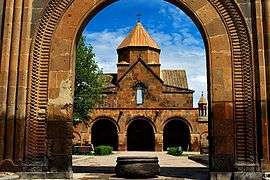 Saint Gayane Church, opened in 630
Saint Gayane Church, opened in 630 Shoghakat Church, opened in 1694
Shoghakat Church, opened in 1694 Zvartnots Cathedral, opened in 652
Zvartnots Cathedral, opened in 652
Culture
.jpg)

Vagharshapat is the cultural center of Armavir and one of the important centers of the entire republic. The Komitas Palace of Culture is operating in the town since 1957, while the Ejmiatsin National Gallery is operating since 1970.
The town is also home to a number of museums including the Vagharshapat Ethnographic Museum, Khoren Ter-Harutyunyan Museum and Gallery, Mher Abeghian Museum and Gallery, and Hovhannes Hovhannisyan House-museum. However, the most prominent museums of Vagharshapat are located within the Mother See complex, including:
- Etchmiadzin Cathedral Museum opened in 1869 by Catholicos George IV,
- The Catholicosal Museum within the old pontifical residence or Hin Veharan built in 1738–1741 and serves as Catholicosal Museum since 1968.[29]
- Khrimian Museum: built and opened in 1896 by Catholicos Mkrtich I of Van. It was recently renovated to become a museum of art.[30]
- Alex and Marie Manoogian Treasury House: opened on 11 October 1982, designed by architect Baghdasar Arzoumanian. The museum is home to treasures of the Armenian Church throughout history.
- Ruben Sevak Museum: opened in 2013 within the Ghazarapat building of the Mother See.
The Mother See is also home to the Pontifical Bookstore operating since 1962, and the *Vatche and Tamar Manoukian Manuscript Depository opened in 2012.[31][32][33]
The town celebrates the "Ejmiatsin Day" annually since 2008 in Vagharshapat on 8 October. According to the old Armenian tradition, Mesrop Mashtots brought the newly created Armenian alphabet to Vagharshapat on 8 October 405.[34]
Transportation

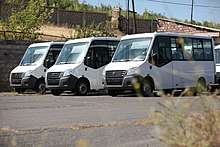
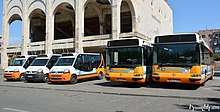
Vagharshapat is connected with Yerevan and southern Armenia through the M-5 Motorway, while the M-3 Motorway connects the town with northern Armenia.
The Zvartnots International Airport of Yerevan is located only 10 kilometres (6 miles) east of Vagharshapat.
Being located 20 km west of the capital Yerevan, Vagharshapat is connected with the capital city with public vans, locally-known as marshrutka. These vehicles are mainly Russian-made GAZelle vans with 13 seats, having regular trips between the two cities throughout the day. Since 2018, some new buses are also having regular trips to Yerevan. There are also 2 smart stops in the city that will soon be eight.
Economy
Industry
Vagharshapat was home to the 1st paper factory in the history of Armenia. In 1780, Catholicos Simeon I of Yerevan founded the Etchmiadzin Paper Factory which served for 6 years.
Under the Soviet rule, the town was turned into an important industrial centre. It was home to 4 major industrial firms specialized in the production of military technology. However, the productivity of the plants declined after the fall of the Soviet Union.
Currently, the industry of the town is mainly based on food-processing. The largest industrial firms of the town are the Ejmiatsin Instrument Making Factory founded in 1966, the E.P.G. Ejmiatsin Cannery founded in 1969, the Ejmiatsin Kat dairy factory founded in 1997, the Sonimol plant for grains founded in 2001, the Ejmiatsin wine brandy and vodka factory founded in 2005, and the Ekologia V.K.H. biological waste destruction plant founded in 2009.[35]
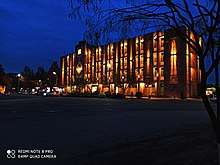
Tourism
Being the spiritual centre of the Armenian nation worldwide, Vagharshapat is a major tourist destination for Armenians as well as foreign visitors. It is home to the UNESCO World Heritage Sites of Etchmiadzin Cathedral, Zvartnots Cathedral, Saint Hripsime Church, Saint Gayane Church and Shoghakat Church, grouped overall as the Cathedral and Churches of Echmiatsin and the Archaeological Site of Zvartnots.
The Machanents Touristic Centre of Vagharshapat provides a unique facility for the visitors of the town. The complex houses a cultural centre with small theatre, pub and jazz club, traditional cuisine, and a boutique hotel.[36] The Zvartnots hotel and casino complex is located at the eastern entrance of the town.
Education
Gevorkian Theological Seminary is one of the most significant educational institutions of Armenia. Other educational institutions include the Grigor Lusavorich University and the intermediate college of vocational education.

The Karekin I Centre of Theology and Armenology is also functioning in the town since 2000.
As of 2009, Vagharshapat is home to 14 public secondary schools, 8 kindergartens and 2 musical academies.[37]
The new complex of Eurnekian School of the Mother See was opened in September 2017.

Sport
FC Vagharshapat was the town's only football club, made its debut in the Armenian Premier League as Zvartnots Echmiadzin in 1992. However, it was dissolved in early 2006 and is currently inactive from professional football. The Etchmiadzin Stadium located immediately to the south of the Mother See complex, is able to hold up to 3,000 spectators.
In October 2016, the Football Federation of Armenia has launched the construction of a football academy at the southern suburb of the town, on the Vagharshapat-Margara motorway. The groundbreaking ceremony took place on 12 April 2017, was attended by President Serzh Sargsyan, UEFA President Aleksander Čeferin and FFA President Ruben Hayrapetyan. With an approximate cost of US$2 million, the complex will occupy an area of 55,601 square metres (598,484 square feet) and is expected to be completed by October 2017. The project is being jointly financed by the FFA, UEFA and FIFA.[38][39]
A new sport school is currently under construction in Vagharshapat since 2015, with a cost of more than US$1 million. The project is due to be completed in 2019.[40]
The nearby village of Aknalich (10 km south of Vagharshapat) is famous for the Ara and Aytsemnik equestrian centre.
International relations
Vagharshapat (Etchmiadzin) has been a member of the Organization of World Heritage Cities (OWHC)[41] since 2007.[42]
Twin towns – sister cities
Vagharshapat is twinned with:[43]






Friendly cities
Vagharshapat also cooperates with:


Notable people
- Zacharias II (?–1520), Catholicos of All Armenians 1515–1520
- Gregory XII (1498–1590), Catholicos of All Armenians 1576–1590
- David IV (?–1633), Catholicos of All Armenians 1590–1629
- Makar Yekmalyan (1856–1905), composer
- Hovhannes Hovhannisyan (1864–1929), poet
- Abraham Gyulkhandanyan (1875–1946), politician and historian
- Levon Manaseryan (1925), painter
- Aram Asatryan (1953–2006), singer
- Khoren Gevor (1980–), professional boxer
- Mihran Harutyunyan (1989-). wrestler, professional MMA fighter and Olympic Silver Medalist
See also
References
- https://armstat.am/en/?nid=81&id=2225
- "Armstats:Population" (PDF). Retrieved 31 January 2013.
- "Պատմաաշխարհագրական ակնարկ [Historical-geographic overview]" (in Armenian). Armavir Province: Armenian Ministry of Territorial Administration. Archived from the original on 28 February 2014. Retrieved 15 April 2014.
...Վաղարշապատ (1945-1995թթ. կոչվել է Էջմիածին) քաղաքը...
- Էջմիածի՞ն, թե՞ Վաղարշապատ. Aravot (in Armenian). 26 October 2010.
- Ring, Trudy; Watson, Noelle; Schellinger, Paul, eds. (1994). International Dictionary of Historic Places: Middle East and Africa, Volume 4. Taylor & Francis. p. 250.
The holy city of Echmiadzin, where the Christian church in Armenia first began...
- Stransky, Thomas F.; Sheerin, John B. (1982). Doing the Truth in Charity: Statements of Pope Paul VI, Popes John Paul I, John Paul II, and the Secretariat for Promoting Christian Unity, 1964-1980. Paulist Press. p. 230.
...from the holy city of Etchmiadzin...
- Համայն հայոց հոգևոր մայրաքաղաքը 2700 տարեկան է, նշվեց Էջմիածնի տոնը (ֆոտոշարք) (in Armenian). Public Radio of Armenia. 8 October 2015.
- James R. Russell. Zoroastrianism in Armenia. — Harvard University Press, 1987. — P. 118.
- Emin, Gevorg (1981). Seven songs about Armenia. Progress. p. 106.
...Ashtarak, Artashat, Etchmiadzin and Abovian because they have become suburbs of Yerevan.
- Bloomfield, Paul (16 May 2015). "Armenia: mountains, monasteries and a glimpse of the land of Noah". The Times.
Our first port of call was Ejmiatsin, a suburb of Yerevan and seat of the Katholikos, head of the Armenian Apostolic Church.
- Stopka, Krzysztof (16 December 2016). Armenia Christiana: Armenian Religious Identity and the Churches of Constantinople and Rome (4th–15th Century). Wydawnictwo UJ. pp. 62-. ISBN 978-83-233-9555-3.
- Zvartnots and the Origins of Christian Architecture in Armenia, W. Eugene Kleinbauer, The Art Bulletin, Vol. 54, No. 3 (September 1972): 261.
- "The Turco-Mongol Invasions". Rbedrosian.com. Retrieved 22 May 2012.
- Smith, Eli; Dwight, H. G. O. (1833). Researches of the Rev. E. Smith and Rev. H.G.O. Dwight in Armenia: Including a Journey Through Asia Minor, and into Georgia and Persia, with a Visit to the Nestorian and Chaldean Christians of Oormiah and Salmas, Volume 2. Crocker and Brewster. p. 93.
- "ՊԱՏՄԱԿԱՆ ԱԿՆԱՐԿ".
- Armenia elects first female mayor
- Ejmiatsin: History
- "Climate: Vagharshapat". Climate-Data.org. Retrieved 14 August 2018.
- "Էջմիածնի Սուրբ Աստվածածին եկեղեցի". armaviritem.am.
- Hakobyan, Tatul (10 December 2015). Հայկական մարզի (1828-1840թթ.) 1000-ից ավելի բնակիչ ունեցող 10 բնակավայրերը (in Armenian). ANI Foundation for Armenian Studies. Archived from the original on 11 December 2015. Retrieved 10 December 2015.
- "Вагаршапат". Brockhaus and Efron Encyclopedic Dictionary Volume V (in Russian). 1891. p. 336.
- "Демоскоп Weekly - Приложение. Справочник статистических показателей". demoscope.ru.
- "Հայաստանի Հանրապետության բնակավայրերի բառարան" (PDF). Armenian State Cadaste. 2008. p. 186.
- "Эчмиадзинский уезд 1926". ethno-kavkaz.narod.ru.
- "Էջմիածին [Ejmiatsin]". Soviet Armenian Encyclopedia Volume 5 (in Armenian). 1978. p. 64.
- "Microsoft Word - 57 PAGE.doc" (PDF). Retrieved 30 April 2018.
- Edwards, Robert W., "Ēĵmiacin" (2016). The Eerdmans Encyclopedia of Early Christian Art and Archaeology, ed., Paul Corby Finney. Grand Rapids, Michigan: William B. Eerdmans Publishing. pp. 455–456. ISBN 978-0-8028-9016-0.
- "Yeghishe.am: Shoghakat". Archived from the original on 6 July 2011. Retrieved 22 November 2010.
- Old pontifical residence
- Khrimian Museum
- Vatche and Tamar Manoukian Manuscript Depository
- Bookstore
- "The Armenian Church - Մայր Աթոռ Սուրբ Էջմիածին". www.armenianchurch.org.
- "Hetq online: Etchmiadzin Day Celebrated Today". Hetq.am. Retrieved 31 January 2013.
- "Բժշկական թափոնների վնասազերծման գործարան Էջմիածնում - Հետք - Լուրեր, հոդվածներ, հետաքննություններ".
- "Ծանոթ-անծանոթ քաղաքը՝ Էջմիածին".
- "Union of Communities of Armenia: Ejmiatsin". Caa.am. Archived from the original on 11 September 2011. Retrieved 31 January 2013.
- "ՀՖՖ-ն Արմավիրի մարզում իրականացնելու է ֆուտբոլի զարգացման խոշոր ներդրումային ծրագրեր".
- LLC, Helix Consulting. "Working visit of President Serzh Sargsyan to Armavir marz - Domestic visits - Updates - The President of the Republic of Armenia [the official site]". www.president.am.
- "ԷՋՄԻԱԾԻՆԸ ՖՈՒՏԲՈԼԻ ԱԿԱԴԵՄԻԱ ԿՈՒՆԵՆԱ".
- "Echmiatsin, Arménie" (in French). OVPM. Retrieved 31 January 2013.
- Etchmiadzin: International relations(in Russian)
- "Sister cities". Vagharshapat. Retrieved 2 July 2020.
- "Sister cities". HyeTert. 29 January 2020. Retrieved 2 July 2020.
External links


